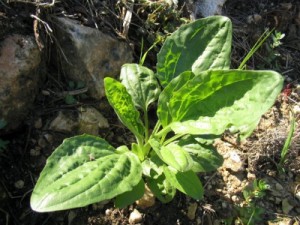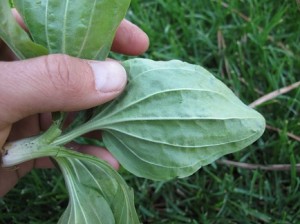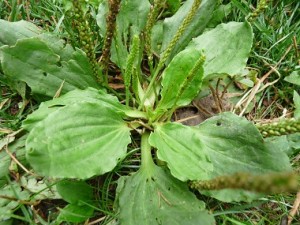Plantain (Plantago major, white man’s foot) is another one of those plants that seems to thrive right on the edge of gardens and driveways, but it’s also edible. Pick the green, rippled leaves and leave the tall flower stems. Blanch the leaves and sauté with some butter and garlic just as you would with kale or any other tough green.
The two most common varieties of wild plantain are the broad leaf plantain and the narrow leaf plantain. Both can be easily distinguished by their long stalk in the middle of the plant with a seed head on top. The leaves are low to the ground and grow in a round pattern around the center seed stalk. The leaves have very clearly defined veins running their length. If you tear a leaf, you can see fibers in the leaf, especially in late summer.
Plantain, like dandelion, is a healthy, hardy weed as ubiquitous in the city as broken glass. You know what it looks like, but you might not have known the name. The Common Broad-leaved Plantain is a very familiar perennial ‘weed,’ and may be found anywhere by roadsides and in meadow-land.
Part of the confusion is that plantain shares its name with something utterly different, the banana-like plantain, whose etymology is a mix of Spanish and native Caribbean. The so-called weed plantain, or Plantago major, was cultivated in pre-Columbus Europe; and indeed Native Americans called it “the white man’s footprint,” because it seemed to follow European settlers.
Plantain has a nutritional profile similar to dandelion — that is, loaded with iron and other important vitamins and minerals. The leaves are tastiest when small and tender, usually in the spring but whenever new shoots appear after being cut back by a lawnmower. Bigger leaves are edible but bitter and fibrous.
Wild plantain can be eaten fresh as a salad green or boiled lightly and eaten like spinach. The seeds can be cooked like cereal or dried and used like flour. You can dry the leaves or seeds and use them later. Fresh or dried leaves can be used in tea. As with most green leafy vegetables, the younger leaves are fresher and less stringy.
It grows from a very short rhizome, which bears below a great number of long, straight, yellowish roots, and above, a large, radial rosette of leaves and a few Iong, slender, densely-flowered spikes. The leaves are ovate, blunt, abruptly contracted at the base into a long, broad, channelled footstalk (petiole). The blade is 4 to 10 inches long and about two-thirds as broad, usually smooth, thickish, five to eleven ribbed, the ribs having a strongly fibrous structure, the margin entire, or coarsely and unevenly toothed. The flower-spikes, erect, on long stalks, are as long as the leaves, 1/4 to 1/3 inch thick and usually blunt. The flowers are somewhat purplish-green, the calyx fourparted, the small corolla bell-shaped and four-lobed, the stamens four, with purple anthers. The fruit is a two-celled capsule, not enclosed in the perianth, and containing four to sixteen seeds.
The Plantain belongs to the natural order Plantaginaceae, which contains more than 200 species, twenty-five or thirty of which have been reported as in domestic use.
The drug is without odor: the leaves are saline, bitterish and acrid to the taste; the root is saline and sweetish.
The glucoside Aucubin, first isolated in Aucuba japonica, has been reported as occurring in many species.
Medicinal Action and Properties: Refrigerant, diuretic, deobstruent and somewhat astringent. Has been used in inflammation of the skin, malignant ulcers, intermittent fever, etc., and as a vulnerary, and externally as a stimulant application to sores. Applied to a bleeding surface, the leaves are of some value in arresting haemorrhage, but they are useless in internal haemorrhage, although they were formerly used for bleeding of the lungs and stomach, consumption and dysentery. The fresh leaves are applied whole or bruised in the form of a poultice. Rubbed on parts of the body stung by insects, nettles, etc., or as an application to burns and scalds, the leaves will afford relief and will stay the bleeding of minor wounds.
http://www.goodhousekeeping.com/home/gardening/weeds-edible-plants-0409#slide-4
http://www.botanical.com/botanical/mgmh/p/placom43.html
http://www.livescience.com/15322-healthiest-backyard-weeds.html
http://www.thediyworld.com/blog/?p=590




Leave a Reply